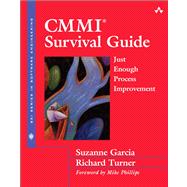The CMMI® Survival Guide is an effective resource for multiple readerships. If you are just now considering a process improvement program, with the CMMI among your options, the authors' discussion of relevant issues will enhance your business case right from the start. If you have already decided to implement the CMMI, the authors' practical knowledge will help you make the most of your efforts. Even if you are well into a CMMI implementation, but are lost, stuck, or going around in circles, the authors' valuable advice will help you regain your direction.
If you work in a smaller or resource-strapped organization, you will particularly benefit from the authors' description of alternative paths to process improvement–approaches that are more incremental or agile, and less intensive, than you might imagine for a CMMI implementation. The authors draw on their extensive experience working with diverse organizations, and on the CMMI tools, techniques, and templates developed for those organizations.
Whatever your background or need, the CMMI® Survival Guide will help you survey the CMMI territory, consult possible road maps, learn from other CMMI explorers, weigh the benefits of hiring a living guide, and even consider whether the trip is right for you.








